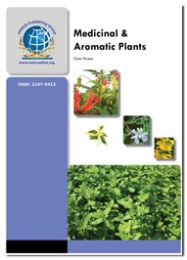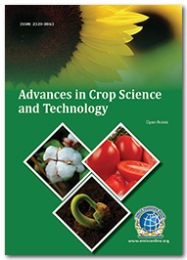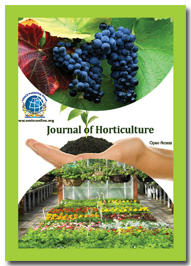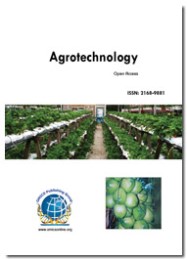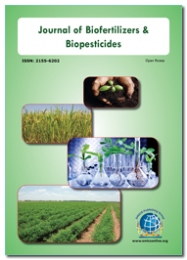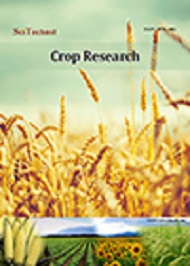Theme: Frontiers in plant genomics : From discovery to applications
Renowned Speakers
Plant Genomics 2016
Track 1: Transgenic Plants
Over the last 30 years, the field of genetic engineering has developed rapidly due to the greater understanding of deoxyribonucleic acid (DNA) as the chemical double helix code from which genes are made. The term genetic engineering is used to describe the process by which the genetic makeup of an organism can be altered using “recombinant DNA technology.” This involves the use of laboratory tools to insert, alter, or cut out pieces of DNA that contain one or more genes of interest. Genetic engineering techniques are used only when all other techniques have been exhausted, i.e. when the trait to be introduced is not present in the germplasm of the crop and some of societies associated with transgenic plants includes American Society of Plant Biologists (ASPB),Australian Society of Plant Scientists (ASPS), Argentinean Society of Plant Physiology (SAFV), American Society of Agronomy (ASA ), African Crop Science Society (ACSS), Brazilian Society of Plant Physiology (SBFV)
Related Conferences: International Conference on Plant Physiology June 09-11, 2016 Dallas, USA ; Global Summit on Plant Science September 21-23, 2015 San Antonio, USA; Conference on Agriculture and Horticulture June 27-29, 2016 Cape Town, South Africa ; Conference on Genomics and Pharmacogenomics September 22-24, 2016 Berlin, Germany; Conference on Green Energy and Expo September 21-23, 2015 Orlando, FL, USA; Protein Synthesis and Translational Control September 9 – 13, 2015 Heidelberg, Germany; Workshop on Plant Development and Drought Stress Pacific Grove November 1 - 4, 2015 CA, USA; Plant-Based Vaccines, Antibodies and Biologics June 8-10, 2015 Lausanne, Switzerland; ICBAGE 2015 : Conference on Biodiversity and Agricultural Genetic Engineering March 9 - 10, 2015 Miami, USA; Conference on Chromosomal Genetics and Evolution September 25 - 26, 2015 London, United Kingdom. 2nd Global Summit on Plant Science, October 06-08, 2016 Crowne Plaza, Heathrow, London, UK; 5th International Conference on Agriculture and Horticulture June 27-29, 2016 Cape Town, South Africa ; 6th International Conference on Genomics and Pharmacogenomics September 22-24, 2016 Berlin, Germany; International Conference on Green Energy November 28-30, 2016 Atlanta, USA; Plant Biology 2016 July 9-13 Austin, Texas; 5th Pan American Plants and Bio Energy Meeting August 4-7, 2016, Sante Fe, New Mexico; Plant Genomics Congress September 12-13, 2016 Philadelphia, USA; Plant Biology Europe: EPSO/FESPB 2016 Congress June 26-30, 2016 Prague, Czech Republic; WISP Course on wheat genetics November 21-23. 2016 John Innes Centre, Norwich, UK; International Society for Plant Pathology;
Track 2: Plant Breeding
Plant breeding is the science of maximizing positive genetic traits in plants that people grow. It consists of analytical frameworks that allow researchers to create and select plants that are consistently outstanding in desired traits. The central objective in plant breeding is to improve the genetic basis of commercial crop species to comply with changing demands on yield and quality. Statistics plays a key role in modern plant breeding. A classical quantitative genetic model writes the phenotype as an outcome of genetic, environmental and genotype by environment interaction effects. In the genomic era, this classical model has been extended and generalized. Linear mixed models played an important role in classical quantitative genetics and still do so inmodern genetics. The availability of genomic tools and resources is leading to a new revolution of plant breeding, as they facilitate the study of the genotype and its relationship with the phenotype, in particular for complex traits and few societies associated with Plant breeding includes Botanical Society of China (BSC),Canadian Society of Plant Biologists (CSPB), Chile’s National Network of Plant Biologists (CNNPB), Chinese Society of Plant Biology (CSPB), Crop Science Society of America (CSSA), Crop Science Society of China(CSSC), European Association for Research on Plant Breeding (EUCARPIA)
Related Conferences: Conference on Plant Physiology June 09-11, 2016 Dallas, USA ; Global Summit on Plant Science September 21-23, 2015 San Antonio, USA; Conference on Agriculture and Horticulture June 27-29, 2016 Cape Town, South Africa ; Conference on Genomics and Pharmacogenomics September 22-24, 2016 Berlin, Germany; Conference on Green Energy and Expo September 21-23, 2015 Orlando, FL,USA; Plant Breeding Congress and EUCARPIA-Oil and Protein Crops Section Conference November 01-05 Antalya ,Turkey; Conference on Rye Breeding and Genetics June 24 – 26, 2015 WrocÅ‚aw, Poland; Congress of Plant Molecular Biology(IPMB) October 25 - 30, 2015 Foz do Iguazu, Brazil; Plant Genomics Congress September 14-15, 2015 St. Louis, USA; XVIth Meeting of the EUCARPIA Section Biometrics in Plant Breeding September 9-11, 2015 Wageningen, the Netherlands
Track 3: Plant Epigenetics
A number of epigenetic phenomena were discovered in plants, but are not limited to plants. For instance, paramutation describes the heritable change in expression status of an allele upon its exposure to an allele that has the same sequence but displays a different expression status. Plant biology has made to the discovery and study of epigenetic phenomena, plants provide ideal systems for epigenomics research. Epigenomic modifications alter gene expression without changing the letters of the DNA alphabet (A-T-C-G), providing cells with an additional tool to fine-tune how genes control the cellular machinery. By understanding epigenomic alterations in plants, scientists may be able to manipulate them for various purposes, including biofuels and creating crops that can withstand stressful events such as drought some of societies associated with Plant Epigenetics includes American Society of Plant Biologists (ASPB), Australian Society of Plant Scientists (ASPS),Argentinean Society of Plant Physiology (SAFV), American Society of Agronomy (ASA), African Crop Science Society (ACSS), Brazilian Society of Plant Physiology (SBFV), Botanical Society of China (BSC), Canadian Society of Plant Biologists (CSPB), Chile’s National Network of Plant Biologists (CNNPB), Chinese Society of Plant Biology (CSPB), Crop Science Society of America (CSSA), Crop Science Society of China (CSSC),European Association for Research on Plant Breeding (EUCARPIA)
Related Conferences: International Conference on Plant Physiology June 09-11, 2016 Dallas, USA ; Global Summit on Plant Science September 21-23, 2015 San Antonio, USA; Conference on Agriculture and Horticulture June 27-29, 2016 Cape Town, South Africa ; Conference on Genomics and Pharmacogenomics September 22-24, 2016 Berlin, Germany; Conference on Green Energy and Expo September 21-23, 2015 Orlando, FL, USA; Conference on Chromosomal Genetics and Evolution September 25 - 26, 2015 London, United Kingdom; EMBL Symposium — The mobile genome: Genetic and physiological impacts of transposable elements September 16-19, 2015 Heidelberg, Germany; The Epigenetics Discovery Congress London September 24–25, 2015 London, United Kingdom; Plant Epigenetics: From Genotype to Phenotype February, 15–19 2016 Taos, United States; EMBO/EMBL Symposium: Chromatin and Epigenetics May 6 – 10, 2015 Heidelberg, Germany;
Track4: Genome Sequencing
Plant Genomics researchers have readily embraced new algorithms, technologies and approaches to generate genome, transcriptome and epigenome datasets for model and crop species that have permitted deep inferences into plant biology. When a species’ reference genome is available, whole-genome resequencing is an efficient approach for discovering genes, SNPs, and structural variants, while simultaneously determininggenotypes. Information from these studies will fill in the gaps that exist in the genetic maps of many plant species, improving plant breeding and selection, and enabling definitive comparative genomic analyses within and across species and few associations includes The Australian biotechnology association, European federation of biotechnology ,European molecular biology laboratory, The human genome variation society, Human Proteome Organisation, The centre for genetic engineering and biotechnology, Protein research foundation, World health organization
Related Conferences: International Conference on Plant Physiology June 09-11, 2016 Dallas, USA ; Global Summit on Plant Science September 21-23, 2015 San Antonio, USA; Conference on Agriculture and Horticulture June 27-29, 2016 Cape Town, South Africa ; Conference on Genomics and Pharmacogenomics September 22-24, 2016 Berlin, Germany; Conference on Green Energy and Expo September 21-23, 2015 Orlando, FL, USA; Conference on Chromosomal Genetics and Evolution September 25 - 26, 2015 London, United Kingdom; EMBL Symposium — The mobile genome: Genetic and physiological impacts of transposable elements September 16-19, 2015 Heidelberg, Germany; The Epigenetics Discovery Congress London September 24–25, 2015 London, United Kingdom; Plant Epigenetics: From Genotype to Phenotype February, 15–19 2016 Taos, United States; EMBO/EMBL Symposium: Chromatin and Epigenetics May 6 – 10, 2015 Heidelberg, Germany;
Track5: Plant Genomics Applications
Recent technological advancements have substantially expanded our ability to analyze and understand plant genomes and to reduce the gap existing between genotype and phenotype. The fast evolving field of genomicsallows scientists to analyze thousands of genes in parallel, to understand the genetic architecture of plant genomes and also to isolate the genes responsible for mutations. Model organisms provide genetic and molecular insights into the biology of more complex species. Since the genomes of most plant species are either too large or too complex to be fully analyzed, the plant scientific community has adopted model organisms. They share features such as being diploid and appropriate for genetic analysis, being amenable to genetic transformation, having a (relatively) small genome and a short growth cycle, having commonly available tools and resources, and being the focus of research by a large scientific community. Genomics will accelerate the application of gene technology to agriculture. Plant genomics research now accounts for only 2% of the U.S. federal research and development budget, despite a 35% rate of return to society. some of societies associated with Plant Genomics Applications includes American Society of Plant Biologists (ASPB), Australian Society of Plant Scientists (ASPS), Argentinean Society of Plant Physiology (SAFV), American Society of Agronomy (ASA),African Crop Science Society (ACSS), Brazilian Society of Plant Physiology (SBFV)
Related Conferences: International Conference on Plant Physiology June 09-11, 2016 Dallas, USA ; Global Summit on Plant Science September 21-23, 2015 San Antonio, USA; Conference on Agriculture and Horticulture June 27-29, 2016 Cape Town, South Africa ; Conference on Genomics and Pharmacogenomics September 22-24, 2016 Berlin, Germany; Conference on Green Energy and Expo September 21-23, 2015 Orlando, FL, USA; Plant Genomes and Biotechnology: from genes to networks Dec ember 02-05, 2015 Berlin, Germany; Plant Genome Evolution 2015 September, 6 - 8 2015 Amsterdam, The Netherlands; GET Global Conference September 17-19, 2015 Vienna, Austria; Immunogenomics 2015September 28-30, 2015, Huntsville, Alabama; The Conference on Genomics Shenzhen October 22-25, 2015 Shenzhen, China; Plant Genomics Congress September 14-15, 2015 St. Louis, MO, USA;
Track6: Plant Tissue Culture
Plant cells can be grown in isolation from intact plants in tissue culture systems. The cells have the characteristics of callus cells, rather than other plant cell types. These are the cells that appear on cut surfaces when a plant is wounded and which gradually cover and seal the damaged area. The plant cells can grow on a solid surface as friable, pale-brown lumps (called callus), or as individual or small clusters of cells in a liquid medium called a suspension culture. These cells can be maintained indefinitely provided they are sub-cultured regularly into fresh growth medium.
Tissue culture cells generally lack the distinctive features of most plant cells. They have a small vacuole, lack chloroplasts and photosynthetic pathways and the structural or chemical features that distinguish so many cell types within the intact plant are absent. They are most similar to the undifferentiated cells found in meristematic regions which become fated to develop into each cell type as the plant grows. Tissue cultured cells can also be induced to re-differentiate into whole plants by alterations to the growth media. Plant tissue cultures can be initiated from almost any part of a plant. The physiological state of the plant does have an influence on its response to attempts to initiate tissue culture. The parent plant must be healthy and free from obvious signs of disease or decay. The source, termed explant, may be dictated by the reason for carrying out the tissue culture. Younger tissue contains a higher proportion of actively dividing cells and is more responsive to a callus initiation programme. The plants themselves must be actively growing, and not about to enter a period of dormancy. some of societies associated with Plant Tissue Culture includes American Society of Plant Biologists (ASPB),Australian Society of Plant Scientists (ASPS), Argentinean Society of Plant Physiology (SAFV), American Society of Agronomy (ASA), African Crop Science Society (ACSS), Brazilian Society of Plant Physiology (SBFV)
Related Conferences: International Conference on Plant Physiology June 09-11, 2016 Dallas, USA ; Global Summit on Plant Science September 21-23, 2015 San Antonio, USA; Conference on Agriculture and Horticulture June 27-29, 2016 Cape Town, South Africa ; Conference on Genomics and Pharmacogenomics September 22-24, 2016 Berlin, Germany; Conference on Green Energy and Expo September 21-23, 2015 Orlando, FL, USA; Plant Genomes and Biotechnology: from genes to networks Dec ember 02-05, 2015 Berlin, Germany; Plant Genome Evolution 2015 September, 6 - 8 2015 Amsterdam, The Netherlands; GET Global Conference September 17-19, 2015 Vienna, Austria; Immunogenomics 2015 September 28-30, 2015, Huntsville, Alabama; The Conference on Genomics Shenzhen October 22-25, 2015 Shenzhen, China; Plant Genomics Congress September 14-15, 2015 St. Louis, MO, USA;
Track7: Mendilian Genetics
In the 1860’s, an Austrian monk named Gregor Mendel introduced a new theory of inheritance based on his experimental work with pea plants. Prior to Mendel, most people believed inheritance was due to a blending of parental ‘essences’, much like how mixing blue and yellow paint will produce a green colour. Mendel instead believed that heredity is the result of discrete units of inheritance, and every single unit (or gene) was independent in its actions in an individual’s genome. According to this Mendelian genetics concept, inheritance of a trait depends on the passing- one of these units.
Mendelian Genetics is widely regarded as the corner stone of classical genetics. It is a set of primary beliefs relating to the transmission of hereditary characteristic from parent organisms to their offspring; it underlies much of genetics. Off spring is the product of You do not have access to view this node, a new organism produced by one or more parents.
Related Conferences: International Conference on Plant Physiology June 09-11, 2016 Dallas, USA ; Global Summit on Plant Science September 21-23, 2015 San Antonio, USA; Conference on Agriculture and Horticulture June 27-29, 2016 Cape Town, South Africa ; Conference on Genomics and Pharmacogenomics September 22-24, 2016 Berlin, Germany; Conference on Green Energy and Expo September 21-23, 2015 Orlando, FL, USA; Plant Genomes and Biotechnology: from genes to networks Dec ember 02-05, 2015 Berlin, Germany; Plant Genome Evolution 2015 September, 6 - 8 2015 Amsterdam, The Netherlands; GET Global Conference September 17-19, 2015 Vienna, Austria; Immunogenomics 2015 September 28-30, 2015, Huntsville, Alabama; The Conference on Genomics Shenzhen October 22-25, 2015 Shenzhen, China; Plant Genomics Congress September 14-15, 2015 St. Louis, MO, USA;
Track8: Plant Genomics in World Economy
The global market for genomics is expected to reach USD 22.1 billion by 2020, growing at an estimated CAGR of 10.3% from 2014 to 2020, according to a new study by Grand View Research, Inc. Genomics play an imperative role in the field of infectious disease testing by enabling the use of fast and effective result rendering molecular diagnostic tests. This, coupled with growing prevalence of infectious diseases and hospital acquired infections is expected to drive market growth during the forecast period. Other driving factors for this market include decreasing prices of DNA sequencing, increasing demand for genome analysis in animal and plant feedstock, extensive presence of both private and public external funding programs and growing patient awareness levels. In addition, presence of untapped growth opportunities in emerging countries such as India, Brazil and China and the increasing health awareness are expected to serve this market as future growth opportunities.
Genomics based diagnostics dominated the overall market in terms of revenue at 36.4% in 2013 majorly owing to the presence of a relatively larger number of RandD programs. Genomics based personalized medicine segment on the other hand is expected to grow at the fastest CAGR of over 12.0% from 2014 to 2020 due to increasing demand for population based therapeutic solutions and subsequent increase in RandD initiatives.
Plant Genomics Market Size - $11.1 Billion in 2013, Market Growth - CAGR of 10.3% from 2014 to 2020, Market Trends - Growing demand for personalized medicine and the consequent rise in demand for genomics based RandD initiatives is expected to drive market growth during the forecast period
Related Conferences: International Conference on Plant Physiology June 09-11, 2016 Dallas, USA ; Global Summit on Plant Science September 21-23, 2015 San Antonio, USA; International Conference on Agriculture and Horticulture June 27-29, 2016 Cape Town, South Africa ; International Conference on Genomics and Pharmacogenomics September 22-24, 2016 Berlin, Germany; International Conference on Green Energy and Expo September 21-23, 2015 Orlando, FL, USA; Protein Synthesis and Translational Control September 9 – 13, 2015 Heidelberg, Germany; Workshop on Plant Development and Drought Stress Pacific Grove November 1 - 4, 2015 CA, USA; Plant-Based Vaccines, Antibodies and Biologics June 8-10, 2015 Lausanne, Switzerland; ICBAGE 2015 : International Conference on Biodiversity and Agricultural Genetic Engineering March 9 - 10, 2015 Miami, USA; International Conference on Chromosomal Genetics and Evolution September 25 - 26, 2015 London, United Kingdom;
Track9: Plant Stem Cells
Plants have emerged as powerful production platforms for the expression of fully functional recombinant mammalian proteins. These expression systems have demonstrated the ability to produce complex glycoproteins in a cost-efficient manner at large scale. The full realization of the therapeutic potential of stem cells has only recently come into the forefront of regenerative medicine. Stem cells are programmed cells that can differentiate into cells with specific functions. Regenerative therapies are used to stimulate healing and might be used in the future to treat various kinds of diseases. Regenerative medicine will result in an extended healthy life span. A fresh apple is a symbol for beautiful skin. Hair greying for example could be shown to result from the fact that the melanocyte stem cells in the hair follicle have died off.
Related Conferences: International Conference on Plant Physiology June 09-11, 2016 Dallas, USA ; Global Summit on Plant Science September 21-23, 2015 San Antonio, USA; Conference on Agriculture and Horticulture June 27-29, 2016 Cape Town, South Africa ; Conference on Genomics and Pharmacogenomics September 22-24, 2016 Berlin, Germany; Conference on Green Energy and Expo September 21-23, 2015 Orlando, FL, USA; Protein Synthesis and Translational Control September 9 – 13, 2015 Heidelberg, Germany; Workshop on Plant Development and Drought Stress Pacific Grove November 1 - 4, 2015 CA, USA; Plant-Based Vaccines, Antibodies and Biologics June 8-10, 2015 Lausanne, Switzerland; ICBAGE 2015 : International Conference on Biodiversity and Agricultural Genetic Engineering March 9 - 10, 2015 Miami, USA; Conference on Chromosomal Genetics and Evolution September 25 - 26, 2015 London, United Kingdom;
Track 10: Molecular Farming
The commonly used term ‘molecular farming’ describes the largeâ€scale production of valuable proteins intransgenic plants, including antibodies, vaccines, other pharmaceuticals and industrial proteins. Compared to traditionally used systems such as microbial cultures, plants offer many advantages with respect to economy, quality and safety. The organism or material into which the new genetic information is inserted is often referred to as the expression system since it serves as the system for “expressing” the new product.
Related Conferences: International Conference on Plant Physiology June 09-11, 2016 Dallas, USA ; Global Summit on Plant Science September 21-23, 2015 San Antonio, USA; Conference on Agriculture and Horticulture June 27-29, 2016 Cape Town, South Africa ; Conference on Genomics and Pharmacogenomics September 22-24, 2016 Berlin, Germany; Conference on Green Energy and Expo September 21-23, 2015 Orlando, FL, USA; Protein Synthesis and Translational Control September 9 – 13, 2015 Heidelberg, Germany; Workshop on Plant Development and Drought Stress Pacific Grove November 1 - 4, 2015 CA, USA; Plant-Based Vaccines, Antibodies and Biologics June 8-10, 2015 Lausanne, Switzerland; ICBAGE 2015 : International Conference on Biodiversity and Agricultural Genetic Engineering March 9 - 10, 2015 Miami, USA; Conference on Chromosomal Genetics and Evolution September 25 - 26, 2015 London, United Kingdom;
Track 11: Plant Physiology
Plant Physiology and Biochemistry embraces physiology, biochemistry, molecular biology, biophysics, structure and genetics at different levels, from the molecular to the whole plant and environment. Plant physiology is a sub discipline of botany concerned with the functioning, or physiology, of plants. The field of plant physiology includes the study of all the internal activities of plants—those chemical and physical processes associated with life as they occur in plants. This includes study at many levels of scale of size and time. At the smallest scale are molecular interactions of photosynthesis and internal diffusion of water, minerals, and nutrients.
Related Conferences: International Conference on Plant Physiology June 09-11, 2016 Dallas, USA ; Global Summit on Plant Science September 21-23, 2015 San Antonio, USA; Conference on Agriculture and Horticulture June 27-29, 2016 Cape Town, South Africa ; Conference on Genomics and Pharmacogenomics September 22-24, 2016 Berlin, Germany; Conference on Green Energy and Expo September 21-23, 2015 Orlando, FL, USA; Plant Physiology Congress December 11-14, 2015 New Delhi, India; Inorganic Polyphosphate (polyP) Physiology September 7, 2015 Charles Darwin House, London, United Kingdom; Signalling in Plant Development September 20 – 24, 2015 Brno, Czech Republic
Track 12: Plant Pathology
Plant pathology is the scientific study of diseases in plants caused by pathogens (infectious organisms) and environmental conditions (physiological factors). Plant pathology also involves the study of pathogenidentification, disease etiology, disease cycles, economic impact, plant disease epidemiology, plant disease resistance, how plant diseases affect humans and animals, pathosystem genetics, and management of plant diseases. Plant pathology is an applied science that deals with the nature, causes and control of plant diseases in agriculture and forestry.
Related Conferences: 2nd Global Summit on Plant Science, October 06-08, 2016 Crowne Plaza, Heathrow, London, UK; 5th International Conference on Agriculture and Horticulture June 27-29, 2016 Cape Town, South Africa ; 6th International Conference on Genomics and Pharmacogenomics September 22-24, 2016 Berlin, Germany; Plant Biology 2016 July 9-13 Austin, Texas; 5th Pan American Plants and Bio Energy Meeting August 4-7, 2016, Sante Fe, New Mexico; Plant Genomics Congress September 12-13, 2016 Philadelphia, USA; Plant Biology Europe: EPSO/FESPB 2016 Congress June 26-30, 2016 Prague, Czech Republic; WISP Course on wheat genetics November 21-23. 2016 John Innes Centre, Norwich, UK;
Track 13: Systems Biology
Although ecologists and physiologists have been using a systems approach to study plants for many years, a systems biology approach that reaches to and includes molecular details is only feasible now with the advent of genomic technologies. Thus, the exciting prospect of the post-genomic era is for the first time to be able to integrate knowledge across different levels of biological organization and to anchor this at the molecular level. The biological systems studied in the department, such as cell cycle, lateral root development, cell death, lignification, bud dormancy, leaf development, plant-microbe interactions, are all highly complex and will benefit considerably from the integration in a systems biology approach. Biologists now have the tools at hand to view the global behaviour of their preferred model systems and to better select the genes that are likely to play key roles in the regulation of entire processes.
Related Conferences: International Conference on Plant Physiology June 09-11, 2016 Dallas, USA ; Global Summit on Plant Science September 21-23, 2015 San Antonio, USA; 5th International Conference on Agriculture and Horticulture June 27-29, 2016 Cape Town, South Africa ; International Conference on Genomics and Pharmacogenomics September 22-24, 2016 Berlin, Germany; Conference on Green Energy and Expo September 21-23, 2015 Orlando, FL, USA: Signalling in Plant Development Brno September 20 – 24, 2015, Czech Republic; Systems Biology of Infection Symposium September 6–10, 2015 Ascona, Switzerland; EMBL Symposium — Biological oscillators: Design, mechanism, function November 12–14, 2015 Heidelberg, Germany; Conference on Computational Systems-Biology and Bioinformatics November 22-25, 2015 BANGKOK, Thailand; Winter School on Quantitative Systems Biology December 7-22, 2015 Bangalore, India
Track 14: Cereals and Crops
Comparison of the order of blocks within the different cereal chromosomes revealed that each cereal genome can be derived from the cleavage of a single structure, a hypothetical ‘ancestral’ genome, from which the genomes of present day cereals and grasses have evolved. The rice genome is one of the smallest among the cereals and grasses, and in 1995, we demonstrated that rice could be a model for cereals based on this ‘synteny’ because its genome can be divided into groups of genes - a series of genomic building blocks - from which the other larger cereal genomes can be constructed. The genome analysis will also help in our efforts for improvement of staple foods for yield and quality, which is a continuous process because neither the conditions of cultivation nor the genomes have to be targeted to the need of adaptations to a variety of biotic and abiotic stresses. Functional food components vary across the cereal crops and within different tissues of grain.
Related Conferences: International Conference on Plant Physiology June 09-11, 2016 Dallas, USA ; Global Summit on Plant Science September 21-23, 2015 San Antonio, USA; 5th International Conference on Agriculture and Horticulture June 27-29, 2016 Cape Town, South Africa ; International Conference on Genomics and Pharmacogenomics September 22-24, 2016 Berlin, Germany; Conference on Green Energy and Expo September 21-23, 2015 Orlando, FL, USA: Cereals North America 2015 November 2-4, 2015 Winnipeg, Canada; PEI Soil and Crop Conference February 25-26, 2015 PEI, HGCA; Smart Agriculture September 8, 2015, Birmingham, United kingdom; Cereal and Bread Congress (ICBC) April 17 – 21, 2016 Istanbul, Turkey; Australiasian Grain Science Conference September 16-18, 2015 Sydney, Australia
Track 1: Transgenic Plants
Over the last 30 years, the field of genetic engineering has developed rapidly due to the greater understanding of deoxyribonucleic acid (DNA) as the chemical double helix code from which genes are made. The term genetic engineering is used to describe the process by which the genetic makeup of an organism can be altered using “recombinant DNA technology.” This involves the use of laboratory tools to insert, alter, or cut out pieces of DNA that contain one or more genes of interest. Genetic engineering techniques are used only when all other techniques have been exhausted, i.e. when the trait to be introduced is not present in the germplasm of the crop;
Related Conferences: International Conference on Plant Physiology June 09-11, 2016 Dallas, USA ; Global Summit on Plant Science September 21-23, 2015 San Antonio, USA; 5th International Conference on Agriculture and Horticulture June 27-29, 2016 Cape Town, South Africa ; International Conference on Genomics and Pharmacogenomics September 22-24, 2016 Berlin, Germany; Conference on Green Energy and Expo September 21-23, 2015 Orlando, FL, USA: Protein Synthesis and Translational Control September 9 – 13, 2015 Heidelberg, Germany; Workshop on Plant Development and Drought Stress Pacific Grove November 1 - 4, 2015 CA, USA; Plant-Based Vaccines, Antibodies and Biologics June 8-10, 2015 Lausanne, Switzerland; ICBAGE 2015 : Conference on Biodiversity and Agricultural Genetic Engineering March 9 - 10, 2015 Miami, USA; Conference on Chromosomal Genetics and Evolution September 25 - 26, 2015 London, United Kingdom
Track 2: Plant Breeding
Plant breeding is the science of maximizing positive genetic traits in plants that people grow. It consists of analytical frameworks that allow researchers to create and select plants that are consistently outstanding in desired traits. The central objective in plant breeding is to improve the genetic basis of commercial crop species to comply with changing demands on yield and quality. Statistics plays a key role in modern plant breeding. A classical quantitative genetic model writes the phenotype as an outcome of genetic, environmental and genotype by environment interaction effects. In the genomic era, this classical model has been extended and generalized. Linear mixed models played an important role in classical quantitative genetics and still do so in modern genetics. The availability of genomic tools and resources is leading to a new revolution of plant breeding, as they facilitate the study of the genotype and its relationship with the phenotype, in particular for complex traits.
Related Conferences: International Conference on Plant Physiology June 09-11, 2016 Dallas, USA ; Global Summit on Plant Science September 21-23, 2015 San Antonio, USA; 5th International Conference on Agriculture and Horticulture June 27-29, 2016 Cape Town, South Africa ; Conference on Genomics and Pharmacogenomics September 22-24, 2016 Berlin, Germany; Conference on Green Energy and Expo September 21-23, 2015 Orlando, FL, USA: Protein Synthesis and Translational Control September 9 – 13, 2015 Heidelberg, Germany; Workshop on Plant Development and Drought Stress Pacific Grove November 1 - 4, 2015 CA, USA; Plant-Based Vaccines, Antibodies and Biologics June 8-10, 2015 Lausanne, Switzerland; ICBAGE 2015 : Conference on Biodiversity and Agricultural Genetic Engineering March 9 - 10, 2015 Miami, USA; Conference on Chromosomal Genetics and Evolution September 25 - 26, 2015 London, United Kingdom
Track 3: Plant Epigenetics
A number of epigenetic phenomena were discovered in plants, but are not limited to plants. For instance, paramutation describes the heritable change in expression status of an allele upon its exposure to an allele that has the same sequence but displays a different expression status. plant biology has made to the discovery and study of epigenetic phenomena, plants provide ideal systems for epigenomics research. Epigenomic modifications alter gene expression without changing the letters of the DNA alphabet (A-T-C-G), providing cells with an additional tool to fine-tune how genes control the cellular machinery. By understanding epigenomic alterations in plants, scientists may be able to manipulate them for various purposes, including biofuels and creating crops that can withstand stressful events such as drought.
Related Conferences: International Conference on Plant Physiology June 09-11, 2016 Dallas, USA ; Global Summit on Plant Science September 21-23, 2015 San Antonio, USA; 5th International Conference on Agriculture and Horticulture June 27-29, 2016 Cape Town, South Africa ; International Conference on Genomics and Pharmacogenomics September 22-24, 2016 Berlin, Germany; Conference on Green Energy and Expo September 21-23, 2015 Orlando, FL, USA: Plant Breeding Congress and EUCARPIA-Oil and Protein Crops Section Conference November 01-05 Antalya ,Turkey; Conference on Rye Breeding and Genetics June 24 – 26, 2015 WrocÅ‚aw, Poland; 11th Congress of Plant Molecular Biology(IPMB) October 25 - 30, 2015 Foz do Iguazu, Brazil; Plant Genomics Congress September 14-15, 2015 St. Louis, USA; Meeting of the EUCARPIA Section Biometrics in Plant Breeding September 9-11, 2015 Wageningen, the Netherlands
Track4: Genome Sequencing
Plant Genomics researchers have readily embraced new algorithms, technologies and approaches to generate genome, transcriptome and epigenome datasets for model and crop species that have permitted deep inferences into plant biology. When a species’ reference genome is available, whole-genome resequencing is an efficient approach for discovering genes, SNPs, and structural variants, while simultaneously determininggenotypes. Information from these studies will fill in the gaps that exist in the genetic maps of many plant species, improving plant breeding and selection, and enabling definitive comparative genomic analyses within and across species.
Related Conference: International Conference on Plant Physiology June 09-11, 2016 Dallas, USA ; Global Summit on Plant Science September 21-23, 2015 San Antonio, USA; 5th International Conference on Agriculture and Horticulture June 27-29, 2016 Cape Town, South Africa ; International Conference on Genomics and Pharmacogenomics September 22-24, 2016 Berlin, Germany; Conference on Green Energy and Expo September 21-23, 2015 Orlando, FL, USA: Plant Breeding Congress and EUCARPIA-Oil and Protein Crops Section Conference November 01-05 Antalya ,Turkey; Conference on Rye Breeding and Genetics June 24 – 26, 2015 WrocÅ‚aw, Poland; 11th Congress of Plant Molecular Biology(IPMB) October 25 - 30, 2015 Foz do Iguazu, Brazil; Plant Genomics Congress September 14-15, 2015 St. Louis, USA; Meeting of the EUCARPIA Section Biometrics in Plant Breeding September 9-11, 2015 Wageningen, the Netherlands
Track5: Plant Genomics Applications
Recent technological advancements have substantially expanded our ability to analyze and understand plant genomes and to reduce the gap existing between genotype and phenotype. The fast evolving field of genomicsallows scientists to analyze thousands of genes in parallel, to understand the genetic architecture of plant genomes and also to isolate the genes responsible for mutations. Model organisms provide genetic and molecular insights into the biology of more complex species. Since the genomes of most plant species are either too large or too complex to be fully analyzed, the plant scientific community has adopted model organisms. They share features such as being diploid and appropriate for genetic analysis, being amenable to genetic transformation, having a (relatively) small genome and a short growth cycle, having commonly available tools and resources, and being the focus of research by a large scientific community. Genomics will accelerate the application of gene technology to agriculture. Plant genomics research now accounts for only 2% of the U.S. federal research and development budget, despite a 35% rate of return to society.
Related Conferences: International Conference on Plant Physiology June 09-11, 2016 Dallas, USA ; Global Summit on Plant Science September 21-23, 2015 San Antonio, USA; 5th International Conference on Agriculture and Horticulture June 27-29, 2016 Cape Town, South Africa ; Conference on Genomics and Pharmacogenomics September 22-24, 2016 Berlin, Germany; Conference on Green Energy and Expo September 21-23, 2015 Orlando, FL, USA: Plant Breeding Congress and EUCARPIA-Oil and Protein Crops Section Conference November 01-05 Antalya ,Turkey; Conference on Rye Breeding and Genetics June 24 – 26, 2015 WrocÅ‚aw, Poland; 11th Congress of Plant Molecular Biology(IPMB) October 25 - 30, 2015 Foz do Iguazu, Brazil; Plant Genomics Congress September 14-15, 2015 St. Louis, USA; Meeting of the EUCARPIA Section Biometrics in Plant Breeding September 9-11, 2015 Wageningen, the Netherlands
Track6: Plant Tissue Culture
Plant cells can be grown in isolation from intact plants in tissue culture systems. The cells have the characteristics of callus cells, rather than other plant cell types. These are the cells that appear on cut surfaces when a plant is wounded and which gradually cover and seal the damaged area.The plant cells can grow on a solid surface as friable, pale-brown lumps (called callus), or as individual or small clusters of cells in a liquid medium called a suspension culture. These cells can be maintained indefinitely provided they are sub-cultured regularly into fresh growth medium.
Tissue culture cells generally lack the distinctive features of most plant cells. They have a small vacuole, lack chloroplasts and photosynthetic pathways and the structural or chemical features that distinguish so many cell types within the intact plant are absent. They are most similar to the undifferentiated cells found in meristematic regions which become fated to develop into each cell type as the plant grows. Tissue cultured cells can also be induced to re-differentiate into whole plants by alterations to the growth media. Plant tissue cultures can be initiated from almost any part of a plant. The physiological state of the plant does have an influence on its response to attempts to initiate tissue culture. The parent plant must be healthy and free from obvious signs of disease or decay. The source, termed explant, may be dictated by the reason for carrying out the tissue culture. Younger tissue contains a higher proportion of actively dividing cells and is more responsive to a callus initiation programme. The plants themselves must be actively growing, and not about to enter a period of dormancy.
Related Conferences: International Conference on Plant Physiology June 09-11, 2016 Dallas, USA ; Global Summit on Plant Science September 21-23, 2015 San Antonio, USA; 5th International Conference on Agriculture and Horticulture June 27-29, 2016 Cape Town, South Africa ; Conference on Genomics and Pharmacogenomics September 22-24, 2016 Berlin, Germany; Conference on Green Energy and Expo September 21-23, 2015 Orlando, FL, USA: Conference on Chromosomal Genetics and Evolution September 25 - 26, 2015 London, United Kingdom; EMBL Symposium — The mobile genome: Genetic and physiological impacts of transposable elements September 16-19, 2015 Heidelberg, Germany; The Epigenetics Discovery Congress London September 24–25, 2015 London, United Kingdom; Plant Epigenetics: From Genotype to Phenotype February, 15–19 2016 Taos, United States.
Track7: Mendilian Genetics
In the 1860’s, an Austrian monk named Gregor Mendel introduced a new theory of inheritance based on his experimental work with pea plants. Prior to Mendel, most people believed inheritance was due to a blending of parental ‘essences’, much like how mixing blue and yellow paint will produce a green color. Mendel instead believed that heredity is the result of discrete units of inheritance, and every single unit (or gene) was independent in its actions in an individual’s genome. According to this Mendelian genetics concept, inheritance of a trait depends on the passing-on of these units.
Mendelian Genetics is widely regarded as the corner stone of classical genetics. It is a set of primary beliefs relating to the transmission of hereditary characteristic from parent organisms to their offspring; it underlies much of genetics. Off spring is the product of You do not have access to view this node, a new organism produced by one or more parents.
Related Conferences: International Conference on Plant Physiology June 09-11, 2016 Dallas, USA ; Global Summit on Plant Science September 21-23, 2015 San Antonio, USA; 5th International Conference on Agriculture and Horticulture June 27-29, 2016 Cape Town, South Africa ; International Conference on Genomics and Pharmacogenomics September 22-24, 2016 Berlin, Germany; Conference on Green Energy and Expo September 21-23, 2015 Orlando, FL, USA; Conference on Arabidopsis Research June July 29-03, 2016 Gyeongju , South Korea; EMBO Practical Course: Insights into plant biological processes through phenotyping September 13 -19, 2015 Ghent, Belgium; GET Global Conference September 17-19, 2015 Vienna, Austria; The Conference on Genomics Shenzhen October 22-25, 2015 Shenzhen, China
Track 8: Plant Genomics in World Economy
The global market for genomics is expected to reach USD 22.1 billion by 2020, growing at an estimated CAGR of 10.3% from 2014 to 2020, according to a new study by Grand View Research, Inc. Genomics play an imperative role in the field of infectious disease testing by enabling the use of fast and effective result rendering molecular diagnostic tests. This, coupled with growing prevalence of infectious diseases and hospital acquired infections is expected to drive market growth during the forecast period. Other driving factors for this market include decreasing prices of DNA sequencing, increasing demand for genome analysis in animal and plant feedstock, extensive presence of both private and public external funding programs and growing patient awareness levels. In addition, presence of untapped growth opportunities in emerging countries such as India, Brazil and China and the increasing health awareness are expected to serve this market as future growth opportunities.
Genomics based diagnostics dominated the overall market in terms of revenue at 36.4% in 2013 majorly owing to the presence of a relatively larger number of RandD programs. Genomics based personalized medicine segment on the other hand is expected to grow at the fastest CAGR of over 12.0% from 2014 to 2020 due to increasing demand for population based therapeutic solutions and subsequent increase in RandD initiatives.
Plant Genomics Market Size - $11.1 Billion in 2013, Market Growth - CAGR of 10.3% from 2014 to 2020, Market Trends - Growing demand for personalized medicine and the consequent rise in demand for genomics based RandD initiatives is expected to drive market growth during the forecast period
Related Conferences: 5th International Conference on Agriculture & Horticulture, June 27-29, 2016, Cape Town, South Africa; 7th Global Summit on Agriculture & Horticulture, October 17-19 2016, Kuala Lumpur, Malaysia; 6th Agriculture Industry and Machinary Congress, September 26-28, 2016, Miami, USA; 2nd Global Summit on Plant Science, October 31-November 02, 2016, Baltimore, USA; ISTA Seed Symposium, June 15-17 2016, Tallinn, Estonia; Combined Crops, Soils, Horticulture and Weeds Congress 2016, January 18-21 2016, Free State, Bloemfontein; 18th International Conference on Agronomy and Crop Sciences, September 15-16 2016, Rome, Italy; 7th International Crop Science Congress, August 14-19 2016, Beijing China. Crop Science Society of America;
Track9: Plant Stem Cells
Plants have emerged as powerful production platforms for the expression of fully functional recombinant mammalian proteins. These expression systems have demonstrated the ability to produce complex glycoproteins in a cost-efficient manner at large scale. The full realization of the therapeutic potential of stem cells has only recently come into the forefront of regenerative medicine. Stem cells are unprogrammed cells that can differentiate into cells with specific functions. Regenerative therapies are used to stimulate healing and might be used in the future to treat various kinds of diseases. Regenerative medicine will result in an extended healthy life span. A fresh apple is a symbol for beautiful skin. Hair greying for example could be shown to result from the fact that the melanocyte stem cells in the hair follicle have died off.
Related Conferences: International Conference on Plant Physiology June 09-11, 2016 Dallas, USA ; Global Summit on Plant Science September 21-23, 2015 San Antonio, USA; 5th International Conference on Agriculture and Horticulture June 27-29, 2016 Cape Town, South Africa ; Conference on Genomics and Pharmacogenomics September 22-24, 2016 Berlin, Germany; Conference on Green Energy and Expo September 21-23, 2015 Orlando, FL, USA: Conference on Chromosomal Genetics and Evolution September 25 - 26, 2015 London, United Kingdom; EMBL Symposium — The mobile genome: Genetic and physiological impacts of transposable elements September 16-19, 2015 Heidelberg, Germany; The Epigenetics Discovery Congress London September 24–25, 2015 London, United Kingdom; Plant Epigenetics: From Genotype to Phenotype February, 15–19 2016 Taos, United States
Track 10: Molecular Farming
The commonly used term ‘molecular farming’ describes the largeâ€scale production of valuable proteins intransgenic plants, including antibodies, vaccines, other pharmaceuticals and industrial proteins. Compared to traditionally used systems such as microbial cultures, plants offer many advantages with respect to economy, quality and safety. The organism or material into which the new genetic information is inserted is often referred to as the expression system since it serves as the system for “expressing” the new product.
Related Conferences: International Conference on Plant Physiology June 09-11, 2016 Dallas, USA ; Global Summit on Plant Science September 21-23, 2015 San Antonio, USA; 5th International Conference on Agriculture and Horticulture June 27-29, 2016 Cape Town, South Africa ; Conference on Genomics and Pharmacogenomics September 22-24, 2016 Berlin, Germany; Conference on Green Energy and Expo September 21-23, 2015 Orlando, FL, USA; Plant Genomes and Biotechnology: from genes to networks December 02-05, 2015 Berlin, Germany; Plant Genome Evolution 2015 September, 6 - 8 2015 Amsterdam, The Netherlands; The Plant Genomics Congress September 14-15,2015 Missouri, USA; ProkaGENOMICS — European Conference on Prokaryotic and Fungal Genomics 29 September-2 October 2015 Göttingen, Germany; Meeting on Bioinformatics and OMICs October 27- 30,2015 Varadero, Cuba; The Plant Genomics Congress: September 14-15, 2015 MO, USA;
Track 11: Plant Physiology
Plant Physiology and Biochemistry embraces physiology, biochemistry, molecular biology, biophysics, structure and genetics at different levels, from the molecular to the whole plant and environment. Plant physiology is a sub discipline of botany concerned with the functioning, or physiology, of plants. The field of plant physiology includes the study of all the internal activities of plants—those chemical and physical processes associated with life as they occur in plants. This includes study at many levels of scale of size and time. At the smallest scale are molecular interactions of photosynthesis and internal diffusion of water, minerals, and nutrients.
Related Conferences: International Conference on Plant Physiology June 09-11, 2016 Dallas, USA ; Global Summit on Plant Science September 21-23, 2015 San Antonio, USA; 5th International Conference on Agriculture and Horticulture June 27-29, 2016 Cape Town, South Africa ; Conference on Genomics and Pharmacogenomics September 22-24, 2016 Berlin, Germany; Conference on Green Energy and Expo September 21-23, 2015 Orlando, FL, USA; Plant Genomes and Biotechnology: from genes to networks December 02-05, 2015 Berlin, Germany; Plant Genome Evolution 2015 September, 6 - 8 2015 Amsterdam, The Netherlands; The Plant Genomics Congress September 14-15,2015 Missouri, USA; ProkaGENOMICS — European Conference on Prokaryotic and Fungal Genomics 29 September-2 October 2015 Göttingen, Germany; Meeting on Bioinformatics and OMICs October 27- 30,2015 Varadero, Cuba; The Plant Genomics Congress: September 14-15, 2015 MO, USA; ;
Track 12: plant pathology
Plant pathology is the scientific study of diseases in plants caused by pathogens (infectious organisms) and environmental conditions (physiological factors). Plant pathology also involves the study of pathogenidentification, disease etiology, disease cycles, economic impact, plant disease epidemiology, plant disease resistance, how plant diseases affect humans and animals, pathosystem genetics, and management of plant diseases. Plant pathology is an applied science that deals with the nature, causes and control of plant diseases in agriculture and forestry.
Related Conferences: Conference on Plant Physiology June 09-11, 2016 Dallas, USA ; Global Summit on Plant Science September 21-23, 2015 San Antonio, USA; 5th International Conference on Agriculture and Horticulture June 27-29, 2016 Cape Town, South Africa ; Conference on Genomics and Pharmacogenomics September 22-24, 2016 Berlin, Germany; Conference on Green Energy and Expo September 21-23, 2015 Orlando, FL, USA; National Conference on Algal Technologies January 4th, 2016 Visakhapatnam, India; The Genomics of Common Diseases September 2-5, 2015 Cambridge, UK; 36th New Phytologist Symposium: Cell biology at the plant-microbe interface 29 November – 1 December 2015 Munich, Germany; GPC/SEB Plant Section Symposium on Stress Resilience October 23 – 25 2015 - Iguassu Falls, Brazil ; 12th Conference of the European Chitin Society August 30- September 2, 2015 Münster, Germany
Track 13: Systems Biology
Although ecologists and physiologists have been using a systems approach to study plants for many years, asystems biology approach that reaches to and includes molecular details is only feasible now with the advent of genomic technologies. Thus, the exciting prospect of the post-genomic era is for the first time to be able to integrate knowledge across different levels of biological organization and to anchor this at the molecular level. The biological systems studied in the department, such as cell cycle, lateral root development, cell death, lignification, bud dormancy, leaf development, plant-microbe interactions, are all highly complex and will benefit considerably from the integration in a systems biology approach. Biologists now have the tools at hand to view the global behaviour of their preferred model systems and to better select the genes that are likely to play key roles in the regulation of entire processes.
Related Conferences: International Conference on Plant Physiology June 09-11, 2016 Dallas, USA ; Global Summit on Plant Science September 21-23, 2015 San Antonio, USA; 5th International Conference on Agriculture and Horticulture June 27-29, 2016 Cape Town, South Africa ; Conference on Genomics and Pharmacogenomics September 22-24, 2016 Berlin, Germany; Conference on Green Energy and Expo September 21-23, 2015 Orlando, FL, USA; Plant Genomes and Biotechnology: from genes to networks December 02-05, 2015 Berlin, Germany; Plant Genome Evolution 2015 September, 6 - 8 2015 Amsterdam, The Netherlands; The Plant Genomics Congress September 14-15,2015 Missouri, USA; ProkaGENOMICS — European Conference on Prokaryotic and Fungal Genomics 29 September-2 October 2015 Göttingen, Germany; Meeting on Bioinformatics and OMICs October 27- 30,2015 Varadero, Cuba; The Plant Genomics Congress: September 14-15, 2015 MO, USA
Track 14: Cereals and Crops
Comparison of the order of blocks within the different cereal chromosomes revealed that each cereal genome can be derived from the cleavage of a single structure, a hypothetical ‘ancestral’ genome, from which the genomes of present day cereals and grasses have evolved. The rice genome is one of the smallest among the cereals and grasses, and in 1995, we demonstrated that rice could be a model for cereals based on this ‘synteny’ because its genome can be divided into groups of genes - a series of genomic building blocks - from which the other larger cereal genomes can be constructed. The genome analysis will also help in our efforts for improvement of staple foods for yield and quality, which is a continuous process because neither the conditions of cultivation nor the genomes have to be targeted to the need of adaptations to a variety of biotic and abiotic stresses. Functional food components vary across the cereal crops and within different tissues of grain.
Related Conferences: International Conference on Plant Physiology June 09-11, 2016 Dallas, USA ; Global Summit on Plant Science September 21-23, 2015 San Antonio, USA; 5th International Conference on Agriculture and Horticulture June 27-29, 2016 Cape Town, South Africa ; Conference on Genomics and Pharmacogenomics September 22-24, 2016 Berlin, Germany; Conference on Green Energy and Expo September 21-23, 2015 Orlando, FL, USA; Plant Genomes and Biotechnology: from genes to networks December 02-05, 2015 Berlin, Germany; Plant Genome Evolution 2015 September, 6 - 8 2015 Amsterdam, The Netherlands; The Plant Genomics Congress September 14-15,2015 Missouri, USA; ProkaGENOMICS — European Conference on Prokaryotic and Fungal Genomics 29 September-2 October 2015 Göttingen, Germany; Meeting on Bioinformatics and OMICs October 27- 30,2015 Varadero, Cuba; The Plant Genomics Congress: September 14-15, 2015 MO, USA
Importance and scope
Plant genomics is a mounting and constantly evolving field of study, one which has gained much ground in past years through the development of advanced research and data management tools. Expert researchers explore the current issues and methodologies of this expanding field, specifically addressing areas of gene discovery and the functional analysis of genes with a target on the primary tools and sub-disciplines of genetic mapping, mRNA, protein and metabolite profiling. Plant genomics employ exciting new methods to investigate molecular plant breeding technology and gene functional analysis via transformation, mutation, protein function, and gene expression. The success of transgenic crops has erased the last vestiges of doubt about the value of agricultural biotechnology and triggered large-scale investments in plant genomics. The first genomics technology that was practiced on a large scale was sequencing the 5′ ends of cDNAs, to produce expressed sequence tags (ESTs).
Plant Genomics has roots in agriculture and Plant Genomics also has scope in agriculture fields, medicine, food production and textiles. It is the main source of food for human being. As well as we can get plant proteins, phytochemicals from plants, from medicinal plants some medicines are prepared and which can cure some fatal diseases. Form some recent study it is proved that plant antioxidant helps us to protect from free radical damage. By using Phytochemicals some cancer cell proliferation can be prevented at earlier stage. Beside that we can increase the nutrition value of plant by plant biotechnology and plant breeding. Now days green energy are used as non-conventional source of energy to reduce environmental pollution. So in human life Plant Genomics and plant oriented studies are very much important to sustain in this planet.
Value of Plant genomics to Agriculture and Society
Genomics will accelerate the application of gene technology to agriculture. this technology will enhance food security, by increasing productivity, and food safety, by eliminating Mycotoxins. There is a third benefit, derived from the first two: increased wealth. By accelerating the application of technology, genomics significantly increases the value of seeds and agricultural products. This increase adds much wealth to the customers, company owners, employees, and citizens of the nations in which genetic supply companies operate, and to both producing and importing nations whose food costs consequently are decreased.
Agricultural plant genomics should be publicly funded for several reasons. First, the DNA sequence of plants is necessary for continued low-cost, rapid progress to understand crops. As such, it is an essential resource for scientists in both the public and private sectors. Second, industry needs the public sector to create innovative methods for structuring and analysing databases, which can’t be done without access to genomics resources. Third, genomics is an equalizer in the research world.
Why Brisbane?
Brisbane is the capital and most populous city in the Australian state of Queensland and it is one of the third most famous cities in Australia. Brisbane's metropolitan area has a population of 2.3 million and the South East Queensland urban conurbation centred on Brisbane; encircle a population of more than 3 million. Brisbane is named after the Brisbane River on which it is located, which was named after the Governor of New South Wales from 1821 to 1825, Scotsman Sir Thomas Brisbane.
Brisbane has seen consistent economic growth in recent years as a result of the resources bang. White-collar industries include financial services, information technology, higher education and public sector administration generally concentrated in and around the central business district and recently established office areas in the inner suburbs. Most of the universities and research institutes located nearby Brisbane in Australia offer courses on Agriculture. University of Queensland is the one of the famous college offering courses and Plant Genomics, Plant genetics, Plant breeding
Tourism plays a major role in Brisbane's economy, being the third-most popular destination for international tourists after Melbourne and Sydney. Prominent tourist and amusement areas in Brisbane include the South Bank Parklands, Roma Street Parkland, the City Botanic Gardens, Brisbane Forest Park and Portside Wharf. The Lone Pine Koala Sanctuary opened in 1927 and was the world's first koala sanctuary. The suburb of Mount Coot-tha is home to a popular state forest, and the Brisbane Botanic Gardens.
Why to attend???
The significance of plants in human life is significant. Plants and plant products are essential for us. Food, energy, medicine and so many things we are able to get from plants. This conference seek to bring all such scientist, Noble Laureate, researcher, research scholar, students and people together who are involved in this field and provide them to discuss about their innovation, exchange ideas and interaction with each other.
Major Plant science Associations around the Globe
American Society of Plant Biologists (ASPB)
Australian Society of Plant Scientists (ASPS)
Argentinean Society of Plant Physiology (SAFV)
American Society of Agronomy (ASA)
African Crop Science Society (ACSS)
Brazilian Society of Plant Physiology (SBFV)
Botanical Society of China (BSC)
Canadian Society of Plant Biologists (CSPB)
Chile’s National Network of Plant Biologists (CNNPB)
Chinese Society of Plant Biology (CSPB)
Crop Science Society of America (CSSA)
Crop Science Society of China (CSSC)
European Association for Research on Plant Breeding (EUCARPIA)
European Plant Science Organisation (EPSO)
Federation of European Societies of Plant Biology (FESPB)
Genetics Society of China (GSC)
International Society of Plant Pathology (ISPP)
Indian Society of Plant Physiology (ISPP)
International Crop Science Society (ICSS)
International Society for Horticultural Science (ISHS)
Irish Plant Scientists' Association (IPSA)
International Society for Plant Molecular Biology (ISPMB)
Japanese Society for Plant Cell and Molecular Biology (JSPCMB)
Japanese Society of Plant Physiologists (JSPP)
Korean Society of Plant Biologists (KSPB)
New Zealand Society of Plant Biologists (NZSPB)
Australian Plant Society:
Grassland Society of NSW
Aerial Agricultural Association of Australia
Australian Native Plant Society
AgForce
Agribusiness Association of Australia
AusBiotech
Australasian Plant Pathology Society
Australian Association of Agricultural Consultants (WA)
Australian Certified Organic
Australian Pest Controllers
Australian Society of Soil Science
Target Audience:
The target audience will be Plant Biologist, Microbiologist, plant physiologist, agriculturalist plant pathologist, Molecular and cell biologist researcher or scientist who are researching in cancer biology and using plant product as cancer reducing agent.
Meet Your Target Market With members from around the world focused on learning about Plant Genomics, this is your single best opportunity to reach the largest assemblage of participants from the all Over the World. Conduct demonstrations, distribute information, meet with current, make a splash with a new product line, and receive name recognition at this 3-day event. World-renowned speakers, the most recent techniques, tactics, and the newest updates in Plant Science are hallmarks of this conference.
A Unique Opportunity for Advertisers and Sponsors at this International event:
http://plantgenomics.conferenceseries.com/sponsors.php
The global market for genomics is expected to reach USD 22.1 billion by 2020, growing at an estimated CAGR of 10.3% from 2014 to 2020, according to a new study by Grand View Research, Inc. Genomics play an imperative role in the field of infectious disease testing by enabling the use of fast and effective result rendering molecular diagnostic tests. This, coupled with growing prevalence of infectious diseases and hospital acquired infections is expected to drive market growth during the forecast period. Other driving factors for this market include decreasing prices of DNA sequencing, increasing demand for genome analysis in animal and plant feedstock, extensive presence of both private and public external funding programs and growing patient awareness levels. In addition, presence of untapped growth opportunities in emerging countries such as India, Brazil and China and the increasing health awareness are expected to serve this market as future growth opportunities.
Genomics based diagnostics dominated the overall market in terms of revenue at 36.4% in 2013 majorly owing to the presence of a relatively larger number of R&D programs. Genomics based personalized medicine segment on the other hand is expected to grow at the fastest CAGR of over 12.0% from 2014 to 2020 due to increasing demand for population based therapeutic solutions and subsequent increase in R&D initiatives.
Market Size - $11.1 Billion in 2013, Market Growth - CAGR of 10.3% from 2014 to 2020, Market Trends - Growing demand for personalized medicine and the consequent rise in demand for genomics based R&D initiatives is expected to drive market growth during the forecast period
http://globenewswire.com/news-release/2014/11/12/682426/10107796/en/Global-
Worldwide Institutions Statistics
Companies working on Agriculture
Colleges on Agriculture
OMICS International Conferences invites all the participants from all over the world to attend '4th International Conference on Plant Genomics' during July 14-15, 2016 in Brisbane, Australia which includes prompt keynote presentations, Oral talks, Poster presentations and Exhibitions.
Plant Genomics 2016 is the premier event that brings together a unique and international mix of experts, researchers and decision makers both from academia and industry across the globe to exchange their knowledge, expertise and research innovations to build a world class plant genomics conference.
It’s our greatest pleasure to welcome you to the official website of 4th International Conference on Plant Genomics that aims at bringing together the Professors, Researchers, scientists, Program developers to provide an international forum for the dissemination of original research results, new ideas and practical development experiences which concentrate on both theory and practices. The conference will be held in July14-15, 2016 at Brisbane, Australia. The theme of the conference is around," Frontiers in Plant Genomics: From discovery to applications”. Featuring 2days of scientific workshop, special sessions, speaker & poster session, Industrial Expo. 300+ attendees from all over the world.
The event focuses on aspects such as breeding, molecular marker development, crop/ trait improvement, disease resistance, epigenetics, evolution studies and pathology as well understanding tools to overcome barrier and enable successful data analysis and management. Presentations concentrate not only particular to plant genomics but also crop and forestry research ranging from wheat, barley, maize and rice to potato, tomato, arabidopsis, biofuels and various fruits. OMICS International organizes a conference series of 1000+ Global Events inclusive of 300+ Conferences, 500+ Upcoming and Previous Symposiums and Workshops in USA, Europe & Asia with support from 1000 more scientific societies and publishes 700+ Open access journals which contains over 30000 eminent personalities, reputed scientists as editorial board members.
Why to attend???
With members from around the world focused on learning about Plant Genomics and its advances; this is your best opportunity to reach the largest assemblage of participants from the Plant Science and Genomics community. Conduct presentations, distribute information, meet with current and potential scientists, make a splash with new advancements and developments, and receive name recognition at this 2-day event. World-renowned speakers, the most recent techniques, developments, and the newest updates in Plant Genomics are hallmarks of this conference.
Target Audience:
- Plant Genomics Students, Scientists
- Plant Genomics Researchers
- Plant Genomics Faculty
- Agricultural Colleges
- Plant and Agriculture Associations and Societies
- Business Entrepreneurs
- Training Institutes
- Software developing companies
- Manufacturing Agricultural Devices Companies
Conference Highlights
- Plant Physiology
- Transgenic Plants
- Plant Pathology
- Plant Breeding
- Plant Epigenetics
- Plant Genome Sequencing
- Plant Genomics Applications
- Plant Tissue Culture
- Mendelian Genetics
- Plant Genomics in World Economy
- Plant Stemcells
- Molecular Farming
- System Biology
- Cereals and Crops
- Plant Science
- Bioinformatics
- Single cell Genomics
- Plant Cellular and Molecular Biology
- Rice Genome
- weed Science
To share your views and research, please click here to register for the Conference.
To Collaborate Scientific Professionals around the World
| Conference Date | July 14-15, 2016 | ||
| Sponsors & Exhibitors |
|
||
| Speaker Opportunity Closed | Day 1 | Day 2 | |
| Poster Opportunity Closed | Click Here to View | ||
Useful Links
Special Issues
All accepted abstracts will be published in respective Our International Journals.
Abstracts will be provided with Digital Object Identifier by






















